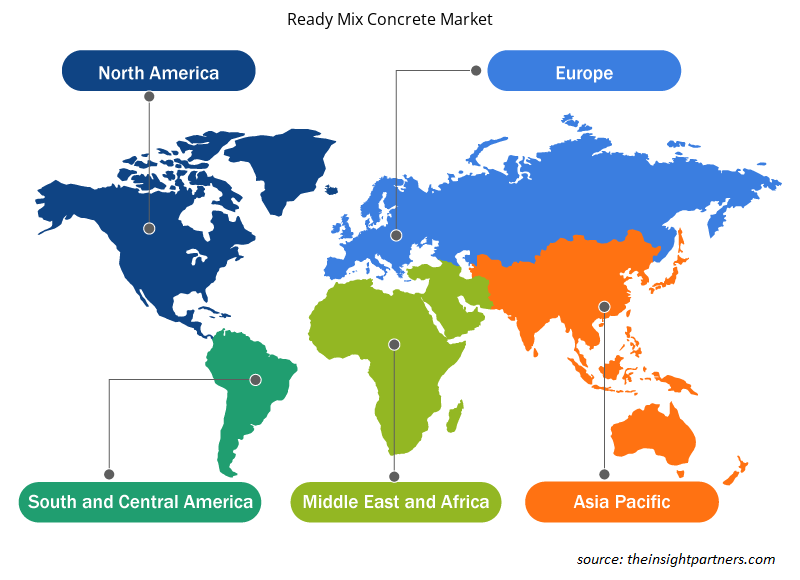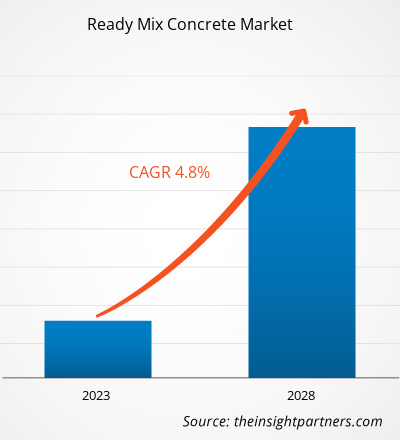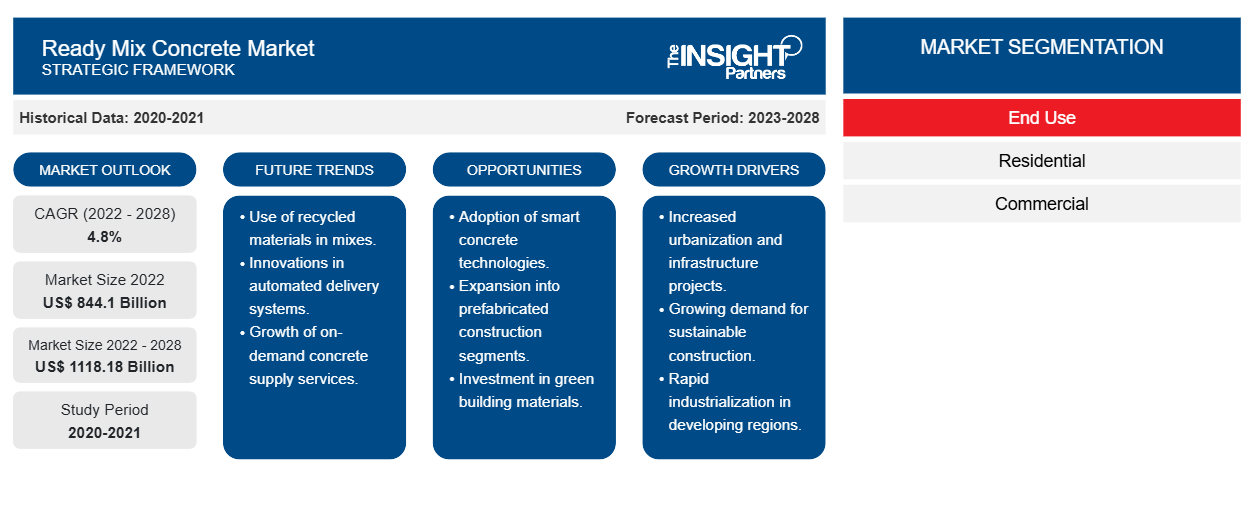Si prevede che il mercato del calcestruzzo preconfezionato crescerà da 844,10 miliardi di dollari nel 2022 a 1.118,18 miliardi di dollari entro il 2028; si stima che crescerà a un CAGR del 4,8% dal 2022 al 2028.
Il calcestruzzo preconfezionato viene prodotto in un impianto di produzione in base a ogni requisito specifico del cantiere. Il calcestruzzo misto transito, il calcestruzzo misto termoretraibile e il calcestruzzo misto centrale sono alcuni dei tipi di calcestruzzo preconfezionato comunemente utilizzati. Il calcestruzzo preconfezionato viene miscelato in un ambiente controllato e può essere utilizzato per una serie di progetti. Il calcestruzzo preconfezionato è sostenibile e ha un'elevata durabilità, il che lo rende molto richiesto in diverse applicazioni.
Nel 2021, l'Asia Pacifica ha detenuto la quota di fatturato più grande del mercato globale del calcestruzzo preconfezionato . La regione è stata notata come uno dei mercati di spicco per l'utilizzo del calcestruzzo preconfezionato a causa dell'aumento delle attività di costruzione. Si prevede che il crescente numero di utilizzi del calcestruzzo preconfezionato in numerosi settori residenziali e non residenziali continuerà ad aumentare la domanda di calcestruzzo preconfezionato nell'Asia Pacifica. Inoltre, iniziative e politiche governative come Make-in-India incoraggiano l'istituzione di diversi impianti di produzione in India.
Personalizza questo report in base alle tue esigenze
Riceverai la personalizzazione gratuita di qualsiasi report, comprese parti di questo report, o analisi a livello nazionale, pacchetto dati Excel, oltre a usufruire di grandi offerte e sconti per start-up e università
- Scopri le principali tendenze di mercato in questo rapporto.Questo campione GRATUITO includerà analisi di dati che spaziano dalle tendenze di mercato alle stime e alle previsioni.
Impatto della pandemia di COVID-19 sul mercato del calcestruzzo preconfezionato
Prima della pandemia di COVID-19, il mercato del calcestruzzo preconfezionato era guidato principalmente dal suo crescente utilizzo in applicazioni residenziali e commerciali. Tuttavia, nel 2020, vari settori hanno dovuto rallentare le loro operazioni a causa delle interruzioni nelle catene del valore causate dalla chiusura dei confini nazionali e internazionali sulla scia della pandemia di COVID-19. Il settore dell'edilizia e delle costruzioni è stato duramente colpito, il che ha avuto un impatto negativo sul consumo di calcestruzzo preconfezionato in diverse regioni. Inoltre, le interruzioni della catena di fornitura hanno interrotto la produzione e la distribuzione di materiali da costruzione. I costruttori hanno riscontrato costi crescenti e ritardi nelle materie prime importate e nei materiali da costruzione fuori sede a causa della chiusura di molte fabbriche per lunghi periodi. La costruzione di edifici è stata quasi trascurabile in Europa a causa della carenza di manodopera e dell'interruzione della catena di fornitura delle materie prime.
Tuttavia, nel 2021, vari paesi hanno iniziato ad allentare le restrizioni. Il mercato globale ha iniziato a riprendersi dalle perdite. Ai produttori è stato consentito di operare a piena capacità, aiutandoli a superare il divario di fornitura. In Europa, vari settori, tra cui l'edilizia e le costruzioni, sono tornati in carreggiata con le limitazioni di fornitura che interessano questi settori che vengono gradualmente risolte. Si prevede che la crescente domanda di calcestruzzo preconfezionato in diverse applicazioni industriali e le crescenti iniziative degli enti governativi per combattere il COVID-19 promuoveranno sostanzialmente il mercato del calcestruzzo preconfezionato a livello globale.
Approfondimenti di mercato
Aumento dei progetti di costruzione commerciale e residenziale
Il calcestruzzo preconfezionato viene utilizzato in quasi tutti i progetti di costruzione grazie a vantaggi quali tempi di costruzione ridotti, bassi costi di manutenzione e versatilità. La rapida crescita della popolazione ha spinto gli enti governativi a promuovere riforme nella pianificazione urbana. Ad esempio, la popolazione di Dubai è aumentata di 0,1 milioni dal 2020 al 2022, con una proiezione governativa di 5,8 milioni entro il 2040. La stabilità economica del paese, una migliore connettività, bassi costi dell'energia e la strategia di diversificazione del governo sono i fattori responsabili della spinta di investitori e clienti a investire in proprietà residenziali e commerciali. Secondo l'Unione Europea, il Fondo europeo di sviluppo regionale (FESR) ha stanziato l'8% per rafforzare lo sviluppo urbano sostenibile e supportare la dimensione urbana della politica di coesione. La strategia di ristrutturazione della Commissione Europea prevede iniziative per l'edilizia abitativa a prezzi accessibili e mira a edifici verdi. Tutti questi fattori stanno influenzando positivamente la crescita del mercato del calcestruzzo preconfezionato.ERDF) allocated 8% to strengthen sustainable urban development and support the cohesion policy's urban dimension. The European Commission’s renovation wave strategy involves affordable housing initiatives and aims for green buildings. All these factors are positively impacting the ready mix concrete market growth.
Approfondimenti basati sull'uso finale
In base all'uso finale, il mercato globale del calcestruzzo preconfezionato è suddiviso in residenziale, commerciale e altri. La quota di mercato del calcestruzzo preconfezionato per il segmento residenziale è stata la più grande nel 2021. Il settore residenziale comprende abitazioni private, appartamenti ed edifici. Gli investimenti e le attività di sviluppo nel settore delle infrastrutture residenziali possono essere attribuiti alla crescita della popolazione e all'urbanizzazione. Inoltre, le politiche governative favorevoli in molti paesi hanno portato alla creazione di edifici residenziali e unità di produzione di calcestruzzo preconfezionato, che si prevede aumenteranno la domanda di calcestruzzo preconfezionato dal settore residenziale.
Tra i pochi attori che operano nel mercato globale del calcestruzzo preconfezionato figurano ACC Limited; Vicat SA; LafargeHolcim; Buzzi Unicem SpA; BARNEY AND DICKENSON INC.; RW Sidley, Inc.; CEMEX SAB DE CV; HEIDELBERGCEMENT AG; ULTRATECH CEMENT LTD.; e CROWN CEMENT PLC. Gli attori che operano nel mercato del calcestruzzo preconfezionato si concentrano sulla fornitura di prodotti di alta qualità per soddisfare le richieste dei clienti. Si concentrano anche su strategie quali investimenti in attività di ricerca e sviluppo e fusioni e acquisizioni.
Segnala i riflettori
- Tendenze industriali progressive nel settore del calcestruzzo preconfezionato per aiutare gli operatori a sviluppare strategie efficaci a lungo termine
- Strategie di crescita aziendale adottate dai mercati sviluppati e in via di sviluppo
- Analisi quantitativa del mercato dal 2020 al 2028
- Stima della domanda globale di calcestruzzo preconfezionato
- Analisi delle cinque forze di Porter per illustrare l'efficacia degli acquirenti e dei fornitori che operano nel settore
- Sviluppi recenti per comprendere lo scenario competitivo del mercato
- Tendenze e prospettive del mercato, nonché fattori che guidano e frenano la crescita del mercato del calcestruzzo preconfezionato
- Assistenza nel processo decisionale evidenziando le strategie di mercato che sostengono l'interesse commerciale, portando alla crescita del mercato
- La dimensione del mercato del calcestruzzo preconfezionato in vari nodi
- Panoramica dettagliata e segmentazione del mercato, nonché dinamiche del settore del calcestruzzo preconfezionato
- Le dimensioni del mercato del calcestruzzo preconfezionato in varie regioni con promettenti opportunità di crescita
Il mercato globale del calcestruzzo preconfezionato è suddiviso in residenziale, commerciale e altri, in base all'utilizzo finale.
Approfondimenti regionali sul mercato del calcestruzzo preconfezionato
Le tendenze regionali e i fattori che influenzano il Ready Mix Concrete Market durante il periodo di previsione sono stati ampiamente spiegati dagli analisti di Insight Partners. Questa sezione discute anche i segmenti e la geografia del Ready Mix Concrete Market in Nord America, Europa, Asia Pacifico, Medio Oriente e Africa e Sud e Centro America.

- Ottieni i dati specifici regionali per il mercato del calcestruzzo preconfezionato
Ambito del rapporto sul mercato del calcestruzzo preconfezionato
| Attributo del report | Dettagli |
|---|---|
| Dimensioni del mercato nel 2022 | 844,1 miliardi di dollari USA |
| Dimensioni del mercato entro il 2028 | 1118,18 miliardi di dollari USA |
| CAGR globale (2022 - 2028) | 4,8% |
| Dati storici | 2020-2021 |
| Periodo di previsione | 2023-2028 |
| Segmenti coperti | Per uso finale
|
| Regioni e Paesi coperti | America del Nord
|
| Leader di mercato e profili aziendali chiave |
|
Densità degli attori del mercato: comprendere il suo impatto sulle dinamiche aziendali
Il mercato del calcestruzzo preconfezionato sta crescendo rapidamente, spinto dalla crescente domanda degli utenti finali dovuta a fattori quali l'evoluzione delle preferenze dei consumatori, i progressi tecnologici e una maggiore consapevolezza dei vantaggi del prodotto. Con l'aumento della domanda, le aziende stanno ampliando le loro offerte, innovando per soddisfare le esigenze dei consumatori e capitalizzando sulle tendenze emergenti, il che alimenta ulteriormente la crescita del mercato.
La densità degli operatori di mercato si riferisce alla distribuzione di aziende o società che operano in un particolare mercato o settore. Indica quanti concorrenti (operatori di mercato) sono presenti in un dato spazio di mercato in relazione alle sue dimensioni o al valore di mercato totale.
Le principali aziende che operano nel mercato del calcestruzzo preconfezionato sono:
- ACC limitata
- Vicat SA
- LafargeHolcim
- Buzzi Unicem SpA
- BARNEY E DICKENSON INC.
Disclaimer : le aziende elencate sopra non sono classificate secondo un ordine particolare.

- Ottieni la panoramica dei principali attori del mercato del calcestruzzo preconfezionato
Profili aziendali
- ACC limitata
- Vicat SA
- LafargeHolcim
- Buzzi Unicem SpA
- BARNEY E DICKENSON INC.
- Società a responsabilità limitata
- CEMEX SAB DI CV
- HEIDELBERGCEMENT AG
- ULTRATECH CEMENT LTD.
- CROWN CEMENT PLC.
- Analisi storica (2 anni), anno base, previsione (7 anni) con CAGR
- Analisi PEST e SWOT
- Valore/volume delle dimensioni del mercato - Globale, Regionale, Nazionale
- Industria e panorama competitivo
- Set di dati Excel
Report recenti
Testimonianze
Motivo dell'acquisto
- Processo decisionale informato
- Comprensione delle dinamiche di mercato
- Analisi competitiva
- Analisi dei clienti
- Previsioni di mercato
- Mitigazione del rischio
- Pianificazione strategica
- Giustificazione degli investimenti
- Identificazione dei mercati emergenti
- Miglioramento delle strategie di marketing
- Aumento dell'efficienza operativa
- Allineamento alle tendenze normative





















 Ottieni un campione gratuito per - Mercato del calcestruzzo preconfezionato
Ottieni un campione gratuito per - Mercato del calcestruzzo preconfezionato